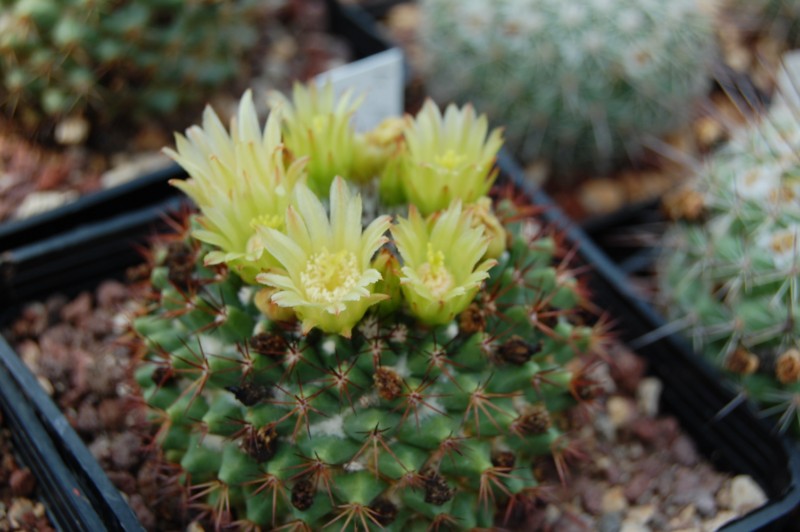Mammillaria marksiana Krainz H. Sukkulentenkunde II Jahrb. Schweiz Kakt. Ges. 1948.
(marksiana after H. Marks, travelling companion of the well-known collector F. Schwarz of Mexico).
Body: With milky sap, light green, broad-globular, not sprouting, about 4.5 cm. high, 8 cm. broad. Apex depressed and woolly. Tubercles in 13 and 21 spirals, pyramidal, somewhat 4 angled about 7 mm. high 7 mm. broad at thebase.
Axils woolly, but in the corky (oldest) zone nake, without bristles.
Areoles, in the apex strongly gold-felted, later becoming naked.
Spines: Radials 8 - 1 0 , spread out, pointing in all directions, straight, stiff and sharp pointed, the lateral spines about 8 mm. long, the upper and lower shorter (about 5 mm. long), reddish yellow to dull golden yellow, becoming grey with age. Central 1 about 8 mm. long, stiff, thin and sharp, golden yellow (like the radials).
Flowers: Short funnelform, about 15 mm. long and wide with small greenish yellow scales outside, having wool in the axils of the scales. Perianth segments 5 mm. long, 2 mm. broad greenish-yellow. Stigma 10 mm. long light yellow. Filements and Anthers pale yellow-
Fruit: Still not known. Seeds: Curved pyriform, light to dark brown about in a reticulate pattern.
Habitat: Mexico, Western Sierra Madre, in Sinaloa State; on rocky slopes in pockets of leafmould (F. Schwarz).
From "The Journal of the Mammillaria Society" - Vol.I n.7 - August 1961
Mammillaria marksiana LAU 621
LAU 621 - Bacuberito - Sinaloa - Mexico

Mammillaria marksiana LAU 621
LAU 621 - Bacuberito - Sinaloa - Mexico

